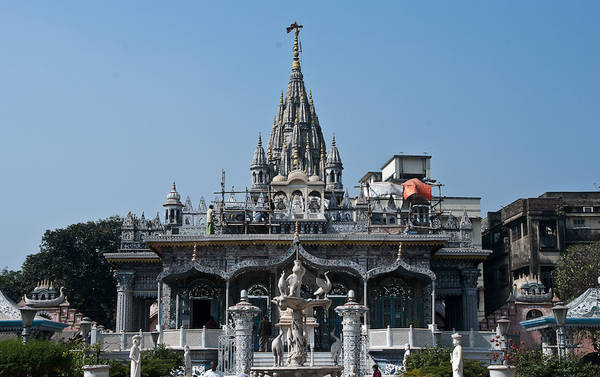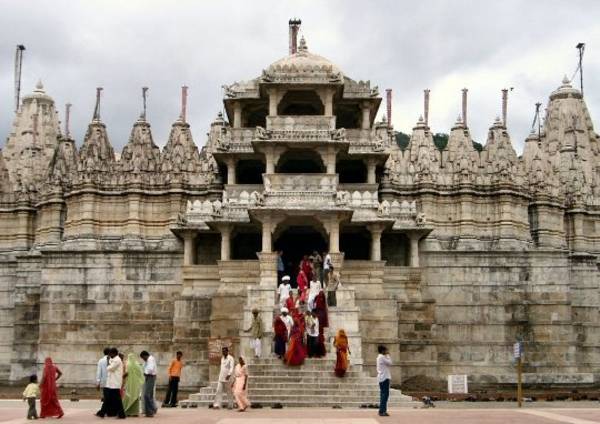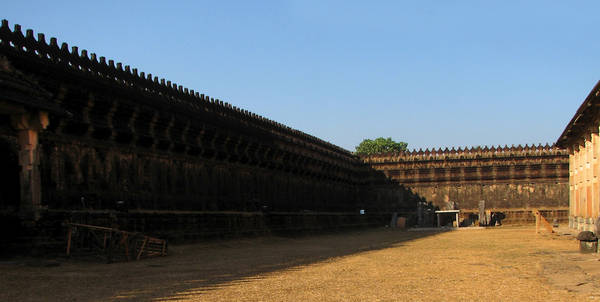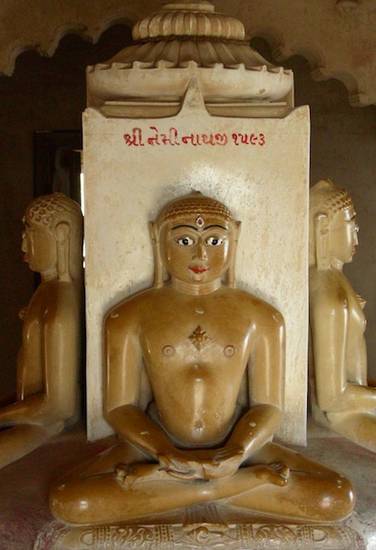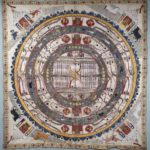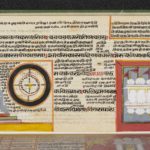Article: Jain temples
Temples associated with different faiths in South Asia often share architectural elements and display styles common in a region and historical period. Although Jain temples frequently share the architectural and artistic elements found in temples of other religions, they are distinctively Jain. Their religious buildings are specifically adapted to Jain spiritual ideas and ritual practices. There are three striking features of Jain religious buildings. Firstly, there is usually more than one shrine in a temple. Next, most are surrounded by additional buildings that form part of the religious building. Lastly, temples are frequently clustered together to produce temple complexes or ‘temple-cities’.
A Jain temple may be referred to by many different names. Terms for ‘temple’ used in early Jainism were sometimes unclear because activities such as teaching, worshipping and residing did not have special areas and often happened in the same place. As buildings and rooms in Jain temples became dedicated to certain purposes over time, so the terminology became more precise. The term used in the present day varies according to the region of India and the local language.
There are several distinct architectural types of Jain temple in India. These range from cave temples, stupas, pavilions built to shelter holy footprints and statues through maṇḍapa-line temples, ‘four-faced’ temples – caturmukha temples – and havelī temples to hall temples, domestic house temples and small shrines found inside private homes. The most common type is that of the maṇḍapa-line temple, which has one or more shrines and halls. Also typical of a Jain religious context are mythological and cosmological temples, which reflect unique Jain cosmological traditions. More rarely found temples are the towering kīrtti-stambha mandirs.
Jain temples are found in all parts of the Indian subcontinent, with particularly well-known examples in Mount Ābū, Rāṇakpur, Mount Śatruñjaya and Śravaṇa Beḷgoḷa. Outside India, Jain temples follow the same model of complex multi-shrined buildings.
Different terms for a Jain temple
There are numerous different words among Jains for a temple. Those which derive from early texts, such as the Jain Āgamas, can be quite vague. In the first centuries CE, the same term could be used to describe cave temples and also the residence of an ascetic and a religious school, as the functions were not clearly separated. Only during later centuries did a more precise set of terms develop, when buildings were put up for specific purposes and followed distinctive layouts. These terms describe and clearly distinguish among the individual buildings and their various roles.
A Jain temple is frequently called by the Sanskrit word caitya and its Prakrit version ceia, which can also be used to describe a religious icon. An alternative word is the Sanskrit balānaka – balāṇaya in Prakrit – which appears to describe only part of a temple structure. An expression common throughout the south of India is paḷḷi. This can be used for a temple, the lodgings of a nun, a cave and even a school. Another example of a word for a Jain temple that has other meanings is vihāra, which can mean both a temple and a monastery.
In modern terminology, Jain temples in the south of India, particularly in Karnataka, are referred to as basadi or basti. Terms commonly used in the north are typically compound phrases consisting of jina before a word meaning ‘house’, ‘residence’, ‘seat’ and so on. This results in words such as jinā-laya and jina-mandir, and terms such as jinā-yatana, jina-gṛha and jina-prāsāda. In Gujarat in particular, and anywhere else the Gujarati community has migrated, Jain temples are usually called derāsar or daherāsar. These are derived from the Sanskrit devagṛhā-vasara. Common modern derivatives are dherī and dehrā.
Parts of a Jain temple
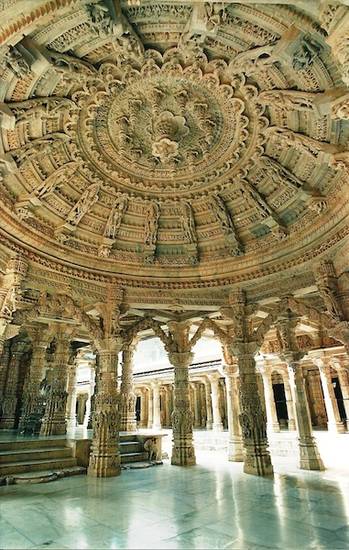
Dome of the Vimala Vasahi
Image by olderock1 – Rakhee © CC BY-NC-ND 2.0
Jain temples demonstrate designs and styles found in many religious buildings constructed for other South Asian faiths. Despite this and the influence of local and historical fashions, Jain temples can often be easily identified because they reflect and support Jain religious beliefs and practices. These unique characteristics include having more than one shrine in a temple and, secondly, several separate, smaller temples or shrines grouped around the central building.
The majority of Jain temples in India consists of three core building elements:
- image-chamber – garbha-gṛha
- hall – maṇḍapa
- porch.
Though these elements vary in number and relative proportions in various temples, all Jain temples are built on a platform. This physically raises the temple above the surrounding land and creates a distinct sacred area. High walls surround the temple compound, further marking off the holy ground of the temple from the ordinary concerns of the householder.
Shrine, hall and porch of a temple
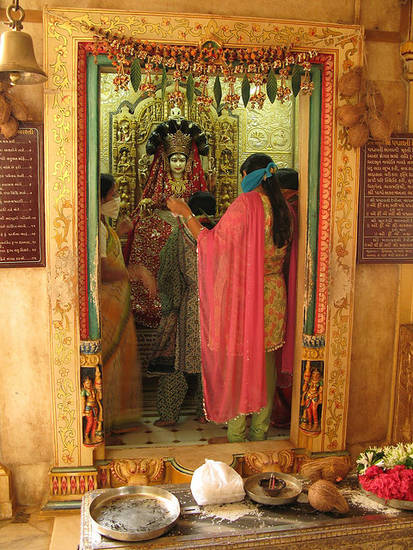
Women and an idol in the temple
Image by Cactusbones – Sue Ann Harkey © CC BY-NC-SA 2.0
The temple’s sanctum is the focal point of the building and may house a statue of a sacred figure or abstract religious element, such as the eight auspicious symbols, the siddhacakra, the cosmic person, yantras and sacred syllables or mantras. In many cases, the shrine holds large numbers of sacred objects. Most temples throughout India have several shrines. These are connected to a hall.
The halls can have side walls and be closed or may simply have pillars, which leave the sides open. Most halls have a pillared interior because the columns are needed to support the ceiling. Temple halls create an approach to the shrine and house more religious statues and ritual equipment. Halls are used for rituals, the recitation of sacred texts and for larger gatherings that involve singing hymns and performing dances.
Porches are very small, simple halls that provide access to shrines and maṇḍapas.
A fourth element may lie between the image-chamber and its hall. The small vestibule – antarāla – is a space in which worshippers can stand and gaze at the icon or follow rituals conducted within the shrine.
In certain temple types, these elements can become exaggerated. In a courtyard temple, for instance, the shrine is usually very wide and spacious and there is an open court in addition to the halls. In a hall-type temple, one major hall acts as the main temple element and the shrine is often not clearly separated, but only indicated by the pavilions or altars raised above the ground at one end of the open hall.
Temple platforms
Jain temples of all types are built on platforms or terraces, commonly referred to as jagatī or vedī. The terraces raise the temples above the ground and create a higher, sacred area that is qualitatively different from the lower profane area surrounding it.
Worshippers take off their shoes before climbing up to the sacred temple area. This ascent, however short, is symbolically related to the idea of the difficulties – durlābha – in reaching sacred places. By extension it also suggests the long journey to the remote goal of enlightenment.
On this pronounced plinth, the temple is protected and appears larger and more monumental. The platforms are often much wider than the actual temple structures and thus provide space for the ritual ambulation – pradakṣiṇā – of the building to take place on the sacred level. This spaciousness also allows further shrines, surrounding the temple building, to be at the same level.
This feature became particularly evolved in the Jain temple architecture of north-western India during the medieval age. Lines of subsidiary shrines were interconnected to create protective walls surrounding the outer edge of the terraces. This helped to physically protect the temple structures and shield them from outside view.
Even rock-cut cave temples have platforms, at least at the front entrance.
The terraces are frequently very high, up to three or four metres tall. In many cases the platforms are tall enough to allow separate apartments or lower image-chambers to be created inside.
Compound walls
Almost without exception, Jain temples are enclosed by high compound walls. Those that do not have walls now very likely had them in the past. Known as prākāra, these walls are usually free-standing detached compound walls, encircling the entire sacred temple area.
Certain types of temple have developed these walls to create defensive, strongly inward-looking buildings. The walls have been merged with the facades of the temples in the compound so there are no separate prākāras. This can happen with all types of temples, but is particularly common in havelī temples.
Beginnings of Jain temple structures
Jain shrines are introduced in the Āgamas and inscriptions around the third century BCE mention Jain temples and statues but the oldest physical evidence of dedicated places of worship dates back to the first centuries CE.
The Jain Āgamas mention shrines dedicated to the siddhas, called siddhā-yatanas, and to śāśvata-caityas. These are eternal shrines in heavenly places, in which gods and goddesses pay homage to sacred representations of the Jinas. There are also textual references to places of Jain worship in connection with the life of Mahāvīra. The 24th Jina is said to have stayed in caityas or so-called vyantara-āyatana or yakṣa-āyatana shrines while a monk. According to Jain legend, Bharata, the oldest son of Ṛṣabhanātha or Lord Ṛṣabha, was the first human being to construct temples dedicated to the 24 Jinas on earth.
Jain inscriptions from as early as the third century BCE mention Jain statues and temples but do not describe them. The earliest available traces of Jain architecture are caves and stupas. Substantial structural remains of Jain temples survive from the first centuries CE, but complete temple buildings have been preserved from only about the seventh century CE. However, these complex remains indicate that earlier structures, which are now lost, must have existed and served as models for later brick and stone constructions.
Types of Jain temple
Jain temple architecture falls into several distinct groups. Especially early Jain structures are often caves. In addition, there are Jain stupas and sacred pavilions housing statues and sanctified foot imprints – pādukās. Most Jain temples in India are made up of one or several shrines and one or a number of halls. This is the maṇḍapa-line type. These temples are highly varied in the vertical and horizontal layouts of shrine rooms. A well-known variant is the so-called ‘four-faced’ temple type, which houses a statue of a Jina made up of four figures. These figures sit or stand back to back and face the four cardinal directions. Locally, they are known as caturmukha temples.
From about the 15th century onwards, Jain temples were often designed around an open courtyard – havelī temples. The hall-type and domestic house temples are a later development. These have been adapted to modern life in cities and reflect changed patterns of pilgrimage. More unusual types of Jain temples are those in the form of tall towers – kīrtti-stambha mandirs – and mythological and cosmological temples, which are closely connected with the distinctive beliefs of the Jain religion. Many Jain families also have private shrines inside their homes.
A well-known characteristic of Jain religious buildings is the ‘temple-city’, in which a large number of separate temples or of walled temple compounds has been built close together. These big complexes can feature all of the different types of Jain temple.
Outside India, Jain temples tend to follow the same characteristic layouts as in India, which can be grouped into the types outlined above.
Reading
- Jaina Temple Architecture in India: The Development of a Distinct Language in Space and Ritual
Julia A. B. Hegewald - Monographien zur Indischen Archäologie, Kunst und Philologie series; volume 19
Stiftung Ernst Waldschmidt, G+H Verlag; Berlin, Germany; 2009
- ‘Multi-shrined Complexes: The Ordering of Space in Jaina Temple Architecture in North-Western India’
Julia A. B. Hegewald - South Asian Studies
volume 17
Taylor & Francis; 2001
Links
- Temple decorated for Dīvālī
-
Jains commemorate the final liberation of the 24th Jina, Mahāvīra, in the festival of Dīvālī in late September or October. At Dīvālī, as in other festivals, statues and temples are lavishly decorated, as shown in this 2007 Flickr photograph of the Katraj temple in Pune, Maharashtra. Lights are festooned everywhere during the 'Festival of Lights', with both electric lighting and traditional clay lamps – dīpas – used. Examples of the ancient auspicious symbol of the svastika, with four dots representing the Jain community or the four states of existence, are clearly seen either side of the temple entrance.
http://www.flickr.com/photos/darvekar/1978597664/in/set-72157603105954957/
- Potters Bar temple – animation
-
This video on YouTube is a computer-generated depiction of the Śvetāmbara Jain temple in Potters Bar, Hertfordshire in England. Completed in 2006 using materials and craftsmen from India, the temple clearly displays the traditional three main elements of porch, hall – maṇḍapa – and image chamber – garbha-gr̥ha. Drawing worshippers and tourists alike, the largest Jain temple in Europe is a very visible statement of the Jain presence in the UK.
- Archaeological Survey of India – history
-
The Archaeological Survey of India was set up in 1784 by Sir William Jones in Calcutta. It began publishing the Asiatick Researches journal in 1788, which publicised the results of surveys of historical sites and monuments in India.
- Images of Jain temples and idols
-
A small selection of drawings and photographs of Jain temples and statues provided by Professor Frances W. Pritchett of Columbia University in New York.
- Jaina temples of Tamil Nadu
-
A scholarly project researching the Jain temples of Tamil Nadu, investigating worship rituals and celebrations in addition to the architecture, art and inscriptions of the buildings. Led by the French Institute of Pondicherry, the project will be published as a CD-ROM.
- James Tod biography
-
An officer in the British East India Company, James Tod (1782–1835) published extensive accounts of the history and geography of India, including details of his travels in Gujarat and Rajasthan between 1819 and 1823. This entry from volume 56 of the Dictionary of National Biography (1885–1900) appears in Wikisource.
- Jina images and temples at Gwalior
-
The pilgrimage centre of Gwalior in central India is famous for its carvings of Jinas. Both freestanding and relief sculptures, the Jinas are found in the temples as well as in panels cut into walls of rock. This collection of drawings and photographs is presented by Professor Frances W. Pritchett of Columbia University in New York.
http://www.columbia.edu/itc/mealac/pritchett/00routesdata/1000_1099/jaintemples/gwalior/gwalior.html
- Early photographs of Mount Abu
-
Historical photographs of Mount Abu, popular pilgrimage site famous for its white marble temples, presented by Professor Frances W. Pritchett of Columbia University in New York.
- Samavasaran Temple
-
A recent building, the Samavasaran Temple is in the town of Palitana at the foot of Mount Shatrunjaya, one of the most important pilgrimage sites for Śvetāmbara Mūrti-pūjaka Jains. Built as a stepped circle, the temple recreates the samavasaraṇa or universal gathering. When a Jina reaches omniscience, he sits in the centre of a samavasaraṇa the gods have built for him so all living beings can hear him preach.
The HereNow4U website has images of the temple.
- Temples of Gujarat
-
Reprint of an article first published as Temples of North India by the Department of Information and Broadcasting in 1975. Offering a brief historical background, the piece summarises key architectural features of both Jain and Hindu temples in northern India.
Provided by Kamat's Potpourri.
http://www.kamat.com/database/content/temples/temples_of_gujarat.htm
- Ayodhyapuram temple
-
This 2009 photo on Flickr shows the recently built temple of Ayodhyapuram in Vallabhipur in Gujarat, which is dedicated to R̥ṣabha. Taking an innovative design, the temple houses a very large statue of the first Jina in the lotus position, which weighs around 23 tonnes.
- Jain temples
-
A comprehensively illustrated examination of Jain temples from an architectural viewpoint. Entitled 'Jaina Architecture in India', the material has been collected by a Japanese architect, Takeo Kamiya, over 30 years. It covers major pilgrimage destinations as well as smaller shrines throughout India.
- Jain Tower and Temple at Chittore
-
Entitled Jain Tower and Temple at Chittore, India this landscape captures a scene that caught the eye of the English artist Marianne North during her journey through India in 1877 to 1878. It is available as part of the Marianne North Online Gallery at the Royal Botanical Gardens, Kew in the United Kingdom.
- Jain temples at the V&A
-
The Victoria and Albert Museum in London presents brief information about Jain temples, accompanied by pictures and photographs.
- +
- aAbhavya
- aAbhinandana
- aAbhiṣeka
- aĀcāra
- aĀcārāṅga-sūtra
- aĀcārya
- aAchalbhrata
- aAḍhāī-dvīpa
- aAdharma
- aAdho-loka
- aAdhyayana
- aAdvaita Vedānta
- aĀgama
- aAghātīya
- aAghātīya-karman
- aAgnibhuti
- aAgra
- aĀhāra
- aAhiṃsā
- aAhimsa Day
- aAjita
- aAjīva
- aAkampit
- aĀkāśa
- aAkbar the Great
- aAkṣaya-tṛtīyā
- aAlauddin Khalji
- aAlbert Einstein
- aAllah
- aAlms
- aĀlocanā
- aAloka-ākāśa
- aAmāri
- aAmbikā or Kūṣmāṇḍinī
- aAnagāra
- aAnanta
- aAnarthadaṇḍa
- aAnaśana
- aAnekānta-vāda
- aAṅga
- aAniconism
- aAnojjā
- aAntarāla
- aAntarāya-karma
- aAṇu
- aAṇu-vrata
- aAnukampā
- aAnuprekṣā
- aAnusvāra
- aApabhraṃśa
- aAparigraha
- aAra
- aĀrambha
- aĀrambhaja
- aĀratī
- aArdhamāgadhī Prākrit
- aArhaṃ
- aArhat
- aArśana-āvaraṇīya-karma
- aĀrta-dhyāna
- aĀryikā
- aĀryikā Jñānamati
- aĀśātanā
- aĀścarya
- aAscetic
- aAsceticism
- aAshram
- aAspiration
- aĀsrava
- aAṣṭa-maṅgala
- aAṣṭāpada
- aAstikāya
- aAstrolabe
- aAsura
- aAtheism
- aAticāra
- aAtiśayakṣetra
- aAtithisaṃvibhāgavrata
- aĀtma-vāda
- aĀtman
- aAuṃ
- aAurangzeb
- aAuspicious
- aAusterity
- aAvadhāna
- aAvadhi-jñāna
- aĀvaraṇī-yakarman
- aAvasarpiṇī
- aAvatāra
- aAvidyā
- aAxiom
- aĀyāga-paṭa
- aĀyambil
- aĀyu-karma
- aĀyurveda
- bBabur
- bBāhubali
- bBaladeva
- bBālāvabodha
- bBandha
- bBasadi
- bBazaar
- bBhadrankarvijay
- bBhagavant
- bBhaktāmara-stotra
- bBhakti
- bBhale
- bBharata
- bBhāṣā
- bBhāṣya
- bBhaṭṭāraka
- bBhāva
- bBhāva-pūjā
- bBhāvanā
- bBhavana-vāsin
- bBhavya
- bBhavyatva
- bBhaya
- bBhoga-bhūmi
- bBhogopabhoga
- bBodhi
- bBollywood
- bBrahmā
- bBrahma-deva
- bBrahmacārī
- bBrāhmaṇa
- bBraj Bhāṣā
- bBright fortnight
- bBritish Raj
- bBuddha
- bBuddhi-sagar
- bBuddhism
- bBuddhist
- cCaitya
- cCaityavāsin
- cCakravartin
- cCakreśvarī
- cCāmara
- cCandanā
- cCandragupta
- cCandraprabha
- cCanon
- cCāritra
- cCāritramohanīya-karman
- cCarũrī
- cCaste
- cCaturvidha-saṅgha
- cCaturviṃśati-stava
- cCāturyāma
- cCE
- cCelibacy
- cCha
- cChadmastha
- cChastity
- cCheda-sūtra
- cChristian
- cChristianity
- cClergy
- cCloning
- cColophon
- cCommentary
- cConch
- cConfession
- cCongregation
- cConsecration
- cCosmology
- cCremation
- cCrore
- cCult
- cCūrṇi
- dDādā-guru
- dDalit
- dDāna
- dDaṇḍa
- dDark fortnight
- dDarśana
- dDarśanamohanī-yakarman
- dDaśa-lakṣaṇa-parvan
- dDeity
- dDelhi Sultanate
- dDerāsar
- dDeśāvakāśika-vrata
- dDetachment
- dDevanāgarī
- dDevānandā
- dDevarddhi-gani
- dDevotee
- dDhamal
- dDhanuṣ
- dDhāra
- dDharma
- dDharma-dhyāna
- dDharma-sāgara
- dDharmastikaya
- dDhātakīkhaṇḍa
- dDholak
- dDhyāna
- dDiaspora
- dDig-vrata
- dDigambara
- dDīkṣā
- dDisciple
- dDīvālī
- dDivya-dhvani
- dDNA
- dDoctrine
- dDogma
- dDonor
- dDoṣa
- dDravya
- dDravya-pūjā
- dDrone
- dDuṣamā
- dDuṣamā-duṣamā
- dDuṣamā-suṣamā
- dDveṣa
- dDvīpa
- eEast India Company
- eEightfold Path
- eEkānta-vāda
- eEkendriya
- eElder
- eElders
- eEschatology
- eEtc up to
- fFarmān
- fFast
- fFatehpur Sikri
- fFestival
- fFestschrift
- fFiruz Shah
- fFly-Whisks
- fFolio
- fFour Noble Truths
- gGaccha
- gGaṇa
- gGaṇadhara
- gGanadharavada
- gGaṇeśa
- gGaṇin
- gGarba
- gGarbha
- gGarbha-gṛha
- gGaruḍa
- gGati
- gGene
- gGenomics
- gGhātī-yakarman
- gGhātīya
- gGhaznavid
- gGhiyasuddin Tughlaq
- gGhurid
- gGloss
- gGotra-karma
- gGujarāt
- gGujarati
- gGuṇa
- gGuṇa-sthāna
- gGuṇa-vrata
- gGupti
- gGuru
- gGuruṇī
- hHagiography
- hHajj
- hHaṃsa
- hHaribhadra
- hHariṇaigameṣin
- hHasta
- hHeresy
- hHiṃsā
- hHindi
- hHindu
- hHinduism
- hHīravijaya
- hHoroscope
- hHrīṃ
- hHumayun
- hHymn
- iIconoclasm
- iIconography
- iIdol
- iIndian Independence
- iIndology
- iIndra
- iIndrabhūti Gautama
- iIndriya
- iInitiation
- iIntercession
- iInvocation
- iIQ
- iIslam
- iIslamicate
- iIṣṭadevatā
- iĪśvara
- jJagat
- jJahangir
- jJain
- jJaina Devanāgarī
- jJaina Śaurasenī
- jJaina-dharma
- jJainaśāsana
- jJainness
- jJaisalmer
- jJamāli
- jJambū-dvīpa
- jJames Burgess
- jJanma
- jJanma-kalyāṇa
- jJarā
- jJāti
- jJina
- jJina-āgama
- jJina-bhavana
- jJina-bimba
- jJina-mātā
- jJinacandra-sūri
- jJinadatta
- jJinaprabha
- jJīva
- jJñāna
- jJñāna-āvaraṇīya-karma
- jJñāna-āvarṇiya
- jJñānsundar
- jJyotiṣka
- kKāla
- kKālakācārya-kathā
- kKālidāsa
- kKalpa-sūtra
- kKalpa-vṛkṣa
- kKalyāṇaka
- kKalyanvijay
- kKamaṇḍalu
- kKamaṭha
- kKarma
- kKarma-bhūmi
- kKarma-grantha
- kKarma-prakṛti
- kKarma-vāda
- kKarmon
- kKarnataka
- kKaṣāya
- kKathā
- kKāvya
- kKāya
- kKāyotsarga
- kKeśa-loca
- kKetu
- kKevala-jñāna
- kKevalin
- kKhalji
- kKharatara-gaccha
- kKnowledge
- kKriyā
- kKriyā-vāda
- kKṛṣṇa
- kKṣamā-śramaṇa
- kKṣapakaśreṇi
- kKṣatriya
- kKṣullaka
- kKulakara
- kKundakunda
- kKunthu
- lLabdhi
- lLaity
- lLakh
- lLāñchana
- lLands of Action
- lLaukāntika
- lLavaṇa-samudra
- lLeśyā
- lLiṅga
- lLinguistics
- lLoka
- lLoka-ākāśa
- lLoka-puruṣa
- lLoka-vāda
- lLotus
- lLotus lake
- mMadhya-loka
- mMahā-videha
- mMahā-vrata
- mMahābhārata
- mMahāmastakābhiṣeka
- mMāhārāṣṭra
- mMāhārāṣṭrī Prākrit
- mMahattarā Yākinī
- mMahāvīr Jayantī
- mMahāvīra
- mMakāra
- mMakkhali Gośāla
- mMalli
- mMāna-stambha
- mManaḥ-paryāya-jñāna
- mMaṇḍala
- mMaṇḍapa
- mMandit
- mMaṅgala
- mMantra
- mMantras
- mManuṣya-loka
- mMarāṭhī
- mMārgaṇā
- mMartyr
- mMarudevī
- mMaṭha
- mMati-jñāna
- mMauryaputra
- mMecca
- mMendicant lineage
- mMetarya
- mMiracle
- mMithyādṛṣṭi
- mMohandas Gandhi
- mMohanīya-karma
- mMokṣa
- mMonastic order
- mMonasticism
- mMonk
- mMonotheism
- mMosque
- mMount Meru
- mMount Sammeta
- mMṛgāvatī
- mMughal
- mMuhammad
- mMuhammad bin Tughlaq
- mMuhpattī
- mMūla-sūtra
- mMūlaguṇa
- mMumbaī
- mMuni
- mMunisuvrata
- mMurad Bakhsh
- mMūrti-pūjaka
- mMuslim
- mMysticism
- nNābhi
- nNāga-kal
- nNāgapurīya Tapā-gaccha
- nNāgarī
- nNāma-karma
- nNamaskāra-mantra
- nNami
- nNandīśvara-dvīpa
- nNandivardhana
- nNandyāvarta
- nNāraka
- nNāraki
- nNasalisation
- nNātha
- nNavrātrī
- nNaya-vāda
- nNemi
- nNidāna
- nniggaṃthāṇa vā 2
- nniggaṃtho vā 2
- nNigoda
- nNihnava
- nNikṣepa
- nNirgrantha
- nNirjarā
- nNirvāṇa
- nNiryukti
- nNiṣidhi
- nNitya
- nNiyati
- nNo-kaṣāya
- nNudity
- nNun
- oOcean of milk
- oOmniscience
- oOrdination
- ppa°
- pPadmaprabha
- pPadmāsana
- pPadmāvatī
- pPādukā
- pPalanquin
- pPalette
- pPañca-muṣṭi
- pPāṇḍava
- pPaṇḍit
- pPandit Dalsukh D. Malvania
- pPandit Sukhlalji
- pPāṇipātra
- pPāpa
- pParamātman
- pParameṣṭhin
- pPāraṇā
- pParigraha
- pPariṇāma
- pParīṣaha
- pParokṣa
- pPārśva
- pPārśvanātha
- pParyāya
- pParyuṣaṇ
- pPaṭa
- pPatan
- pPātra
- pPenance
- pPersian
- pPhala
- pPhilology
- pPicchikā
- pPilgrimage
- pPīr
- pPolymath
- pPoṣadha
- pPossession
- pPothī
- pPrabhas
- pPradakṣiṇā
- pPradeśa
- pPrākāra
- pPrakīrṇaka-sūtra
- pPrākrit
- pPramāda
- pPramukhā
- pPrati-vāsudeva
- pPratikramaṇa
- pPratimā
- pPratiṣṭhā
- pPratyākhyāna
- pPratyakṣa
- pPravacana
- pPrāyaścitta
- pPrayer
- pPre-modern
- pPreach
- pPredestination
- pProtestant
- pProvenance
- pPudgala
- pPūjā
- pPujārī
- pPukharavara-dvīpa
- pPuṇya
- pPūrva
- pPuṣkara-dvīpa
- pPuṣpadanta
- pPyre
- qQur’an
- rRāga
- rRāhu
- rRainy season
- rRajasthan
- rRajasthani
- rRājimatī
- rRajoharaṇa
- rRajput
- rRāma
- rRāmāyaṇa
- rRangoli
- rRās-garbā
- rRasa
- rRathanemi
- rRatna-traya
- rRātri-bhojana
- rRaudra-dhyāna
- rRecto
- rRelic
- rRenunciation
- rRetroflex
- rRevatī
- %Ṛg-veda
- rRite
- rRosary
- %Ṛṣabha
- %Ṛṣabhanātha
- rRupee
- sSaciyā Mātā
- sSādhu
- sSādhvī
- sSāgāra
- sSaint
- sŚaivaism
- sŚaka-saṃvat
- sSallekhanā
- sŚalya
- sSamacatuṣṭha
- sSamādhimaraṇa
- sSamaṇi
- sSāmarambha
- sSamavasaraṇa
- sSāmāyika
- sSaṃbhava
- sSamiti
- sSaṃjñā
- sSaṃkalpaja
- sSaṃsāra
- sSamudghāta
- sSaṃvara
- sSaṃvega
- sSamyak-cāritra
- sSamyak-darśana
- sSamyak-jñāna
- sSamyaktva
- sSaṃyama
- sSanctuary
- sSandalwood
- sSaṇgha
- sSanskrit
- sSant
- sŚānti
- sSapta-bhaṅgi-naya
- sSārambha
- sSarasvatī
- sSarvajña
- sSāsan-devi
- sŚāsana-devatā
- sŚāstra
- %Ṣaṭ-jīvanikāya
- sSatī
- sSatīmātā
- sSatya
- sSchism
- sScribe
- sScripture
- sSect
- sSecularism
- sŚenāī
- sSermon
- sŚeṣavatī
- sSevā
- sSeven fields of donation
- sShah Jahan
- sShantidas Jhaveri
- sShrine
- sSiddha
- sSiddha-śilā
- sSiddhacakra or Navadevatā
- sSiddhānta
- sSiddhārtha
- sSiddhi
- sSikh
- sSikhism
- sŚikṣā-vrata
- sŚīla
- sSin
- sSindh
- sŚītala
- sŚiva
- sSkandha
- sSomanatha
- sŚraddhā
- sŚramaṇa
- sŚrāvaka
- sŚrāvakācāra
- sŚrāvikā
- sŚreyāṃsa
- sŚrī
- sŚrīvatsa
- sŚruta-jñāna
- sŚruta-pañcamī
- sSthānaka-vāsin
- sSthāpanācārya
- sSthāvara
- sSthavira
- sSthiti
- sStrīmukti
- sStūpa
- sSubcontinent
- sSudarshana
- sŚuddhi
- sSudharma
- sŚūdra
- sSufism
- sSukha
- sŚukla-dhyāna
- sSulasā
- sSultan
- sSumati
- sSundarśrī
- sSupārśva
- sSūri
- sSuṣamā
- sSuṣamā-duṣamā
- sSuṣamā-suṣamā
- sSūtra
- sSuyam me ausam! Tenam bhagavaya evamakkhayam
- sSvādhyāya
- sSvāhā
- sSvastika
- sŚvetāmbara
- sŚvetāmbara Terāpanthin
- sŚvetāmbaras
- sSwan
- sSyād-vāda
- tTabla
- tTantra
- tTapā-gaccha
- tTapas
- tTāraṇ Svāmī Panth
- tTattva
- tTattvārtha-sūtra
- tTemple
- tTemple-city
- tThe Enlightenment
- tTheology
- tThree worlds
- %Ṭīkā
- tTilaka
- tTīrtha
- tTīrthaṃkaranāma-karman
- tTīrthankara
- tTransliteration
- tTrasa
- tTrasa-nāḍī
- tTriśalā
- tTriṣaṣṭi-śalākā-puruṣa-caritra
- tTti bemi
- tTughlaq
- tTunk
- uUdumbara
- uUniversal History
- uUpādhyāya
- uUpāṅga
- uUpaniṣads
- uUpāsaka
- uUpasarga
- uUpāśraya
- uŪrdhva-loka
- uUtsarpiṇī
- uUttarādhyayana-sūtra
- vVāhana
- vVaimānika
- vVairāgya
- vVaiṣṇava
- vVaiśramaṇa
- vVaiśya
- vValabhī
- vVanaspatikāya
- vVandana
- vVaṇik
- vVarṇa
- vVāsudeva
- vVāsupūjya
- vVayubhūti
- vVeda
- vVedanīya-karma
- vVegetarianism
- vVehicle
- vVernacular
- vVerso
- vVidyā
- vVidyā-devī
- vVihāra
- vVijñapti-patra
- vVikrama-saṃvat
- vVikṛti
- vVimala
- vVinaya
- vVipāka
- vVirji Vora
- vVirodhaja
- vVīrya
- vVisarga
- vViṣṇu
- vVītarāga
- vVizier
- vVotive
- vVow
- vVrata
- vVS
- vVyakta
- vVyantara
- vVyasana
- yYakṣa
- yYakṣī
- yYantra
- yYaśoda
- yYaśovijaya
- yYati
- yYātrā
- yYoga
- yYoginī
- yYojana


